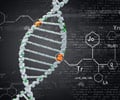Geneticists from Ohio, California and Japan used stem cells to correct a defective ring chromosome with a normal chromosome.

Wynshaw-Boris led this research while a professor in pediatrics, the Institute for Human Genetics and the Eli and Edythe Broad Center of Regeneration Medicine and Stem Cell Research at UC, San Francisco (UCSF) before joining the faculty at Case Western Reserve in June 2013.
Individuals with ring chromosomes may display a variety of birth defects, but nearly all persons with ring chromosomes at least display short stature due to problems with cell division. A normal chromosome is linear, with its ends protected, but with ring chromosomes, the two ends of the chromosome fuse together, forming a circle. This fusion can be associated with large terminal deletions, a process where portions of the chromosome or DNA sequences are missing. These deletions can result in disabling genetic disorders if the genes in the deletion are necessary for normal cellular functions.
The prospect for effective counter measures has evaded scientists—until now. The international research team discovered the potential for substituting the malfunctioning ring chromosome with an appropriately functioning one during reprogramming of patient cells into induced pluripotent stem cells (iPSCs). iPSC reprogramming is a technique that was developed by Shinya Yamanaka, MD, PhD, a co-corresponding author on the Nature paper. Yamanaka is a senior investigator at the UCSF-affiliated Gladstone Institutes, a professor of anatomy at UCSF, and the director of the Center for iPS Cell Research and Application (CiRA) at the Institute for Integrated Cell-Material Sciences (iCeMS) in Kyoto University. He won the Nobel Prize in Medicine in 2012 for developing the reprogramming technique.
Marina Bershteyn, PhD, a postdoctoral fellow in the Wynshaw-Boris lab at UCSF, along with Yohei Hayashi, PhD, a postdoctoral fellow in the Yamanaka lab at the Gladstone Institutes, reprogrammed skin cells from three patients with abnormal brain development due to a rare disorder called Miller Dieker Syndrome, which results from large terminal deletions in one arm of chromosome 17. One patient had a ring chromosome 17 with the deletion and the other two patients had large terminal deletions in one of their chromosome 17, but not a ring. Additionally, each of these patients had one normal chromosome 17.
The researchers observed that, after reprogramming, the ring chromosome 17 that had the deletion vanished entirely and was replaced by a duplicated copy of the normal chromosome 17. However, the terminal deletions in the other two patients remained after reprogramming. To make sure this phenomenon was not unique to ring chromosome 17, they reprogrammed cells from two different patients that each had ring chromosomes 13. These reprogrammed cells also lost the ring chromosome, and contained a duplicated copy of the normal chromosome 13.
Advertisement
"Ring loss and duplication of whole chromosomes occur with a certain frequency in stem cells," explained Bershteyn. "When chromosome duplication compensates for the loss of the corresponding ring chromosome with a deletion, this provides a possible avenue to correct large-scale problems in a chromosome that have no chance of being corrected by any other means."
Advertisement
"In theory, the way you could potentially correct a chromosome with deletions or duplications is to make a ring out of it and then get rid of the ring chromosome during reprogramming," added Wynshaw-Boris. "Ring chromosomes are quite rare, but chromosome abnormalities are much more common and cause a variety of severe birth defects. So far, it is only possible to do this chromosome therapy for cells in culture, not in human beings. However, it may be useful to use this for tissue repair of birth defects and other abnormalities found in individuals with chromosomal abnormalities as techniques for regenerative medicine are developed in the future."
Source-Eurekalert












